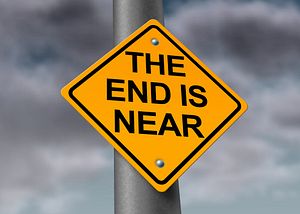Within the Western psyche, the apocalypse has an underlying presence. This has manifested itself through religious faiths and mythology. From the Norse and Ragnarok to Christianity and the End Days, the Western psyche has through the millennia not only believed in creation stories of our existence, but also in Armageddon. In China, this psyche has developed differently.
Apocalypse texts exist in China and are similar to the Revelations. The Divine Incantations Scripture (太上洞渊神咒经) is one such Taoist text. It professes the return of a messianic figure who will take the faithful and destroy the rest of society and create a new society based upon Taoist teachings. The text is believed to have been written in the 5th century AD and many had taken the 7th century ruler Li Hong (李弘) to be the messianic figure. Though the text talks of the destruction of the world, it is symbolic. The world will only be destroyed as it is for those who do not believe in the cause. This is somewhat at odds with the Christian belief.
Even before the Divine Incantations Scripture, “Apocalypse” was being used in a religious sense to undermine the Han Dynasty during the Yellow Turban Rebellion (黄巾之乱) from 184-205 AD. This “Apocalypse” was adopted the rebellion’s leaders as a means to a political end. During this period of history, the massive peasant classes worked for a pittance and faced heavy taxation. This was seen by many Taoists to be oppressive governance that would end in a period of destruction, from which new leadership would emerge. Unlike most Western eschatology, the Chinese in this period saw the end of days as simply the end of a cycle. Chinese history should be viewed as cyclical in nature.
This cycle is dependent on the “Mandate of Heaven” (天命). The mandate was given by the heavens to emperors. It gave them the right to rule on the condition that they rule fairly. If the relationship between the masses and its emperor deteriorates to the point of mass unrest and dissatisfaction, the mandate will pass to those who overthrow the emperor and install a fairer system of governance for the people. During the Yellow Turban rebellion and many other rebellions in Chinese history, the religious aspects of rebellions have been used as a rallying call. This mandate of heaven has very ancient roots in Chinese history and has influenced the Chinese psyche.
Throughout Chinese history the mandate of heaven has been used by new leadership as its source of legitimacy. Many (although certainly not all) dynastic ends could be interpreted as an end of days in one cycle, to be quickly followed by another. The world as people knew it was to end and a new one was to emerge with new governance. Each end signaled bloody rebellion and chaos, which was eventually quelled by new governance.
Today, China only recognizes five religions, Islam Buddhism, Taoism, Catholicism and Protestantism. Party members can be expelled for holding religious beliefs publicly. An Association of Religious Data Archive survey of religion affiliations found in China that 15 percent of the population were strictly atheist, while 85 percent professed some religious beliefs. The majority of this 85 percent likely hold ancestor worship beliefs (祖先崇拜). From a Western perspective, this might be seen more as superstition than a fixed religion.
In essence, religion might be dead but the ancestors remain. A story, perhaps apocryphal, usually attributed to Niels Bohr can explain the phenomenon. A visitor notes that Bohr has a horseshoe hanging above his door, and expresses incredulity that a man of science and reason could possibly be swayed by a simple-minded folk belief. Bohr replies “Of course I don’t believe in it, but I understand it brings you luck, whether you believe in it or not.” This humorous anecdote best explains to me the conundrum of China being effectively atheist while still exhibiting some religious tenancies.
Clearly, there is firm control of religion in China. This could perhaps reflect the fear that in Chinese history large followings have traditionally spelled the end of dynasties. In the Western psyche an apocalypse signifies the end of civilization and the destruction of the world. In China, an apocalypse best highlights the shift in power and the birth of a new form of governance. China might be the PRC today, but the mind-set of the right to rule is still present. However, the right to rule today is based not on a perceived heavenly mandate, but on economic growth. The Chinese Communist Party can probably be assured that as long as China is growing, the end is probably not nigh.
Tomás Swinburne is a recent graduate from Dublin Institute of Technology with an honors degree in Chinese and International Business. This article was originally published on Nihaos It Going?

































